
10 Essential Tips for Growing Double Mahoi Banana Plants
Share
Growing double Mahoi banana plants can be a rewarding endeavor for any gardening enthusiast; however, the path to success is often paved with challenges. Selecting healthy specimens and mastering their specific care needs are crucial steps that play a significant role in ensuring a bountiful harvest. This article presents ten essential tips designed to enhance the growth and yield of double Mahoi banana plants while empowering gardeners to navigate common pitfalls.
How can one ensure their banana plants thrive in varying conditions while maximizing fruit production?
1. Choose Healthy Double Mahoi Banana Plants from Everglades Farm
When selecting double mahoi banana specimens, it is crucial to acquire them from a reliable nursery such as Everglades Farm. Look for plants exhibiting vibrant green foliage, a strong root system, and no signs of pests. Healthy plants are more likely to thrive and bear fruit when nurtured with double mahoi, thereby enriching your gardening experience.
Everglades Farm's dedication to quality ensures that customers receive robust, well-packaged plants ready to flourish in their gardens. Furthermore, consider exploring Everglades Farm's Fast-Growing Trees collection, which features a variety of quick-yield tropical greenery.
Customer testimonials underscore the outstanding service and quality of tropical fruit trees delivered in excellent condition, reinforcing the idea that sourcing from reputable sources leads to successful gardening outcomes. As noted by home gardeners, the positive results of purchasing from Everglades Farm emphasize the importance of high-quality plants and professional-grade fertilizers, such as double mahoi, for achieving optimal growth and fruit yield. This makes it a vital step in your gardening journey.
2. Understand Watering Needs for Double Mahoi Banana Plants
Double Mahoi varieties thrive on consistent moisture, necessitating regular watering to maintain damp soil without saturation. During hot weather, daily watering may be necessary, while cooler months allow for reduced frequency. A practical approach is to check the top 1/2 inch of soil; if it feels dry, it's time to water. This method is crucial in preventing root rot, which often occurs in overly saturated conditions.
As highlighted by horticulturists, "Banana trees are heavy feeders," stressing the necessity for a consistent supply of water to sustain their development. Additionally, maintaining humidity levels between 50 and 60 percent is essential for their health. Under ideal circumstances, plantain trees can produce fruit in only 15 to 18 months after planting, which makes employing double mahoi watering techniques essential for effective cultivation.
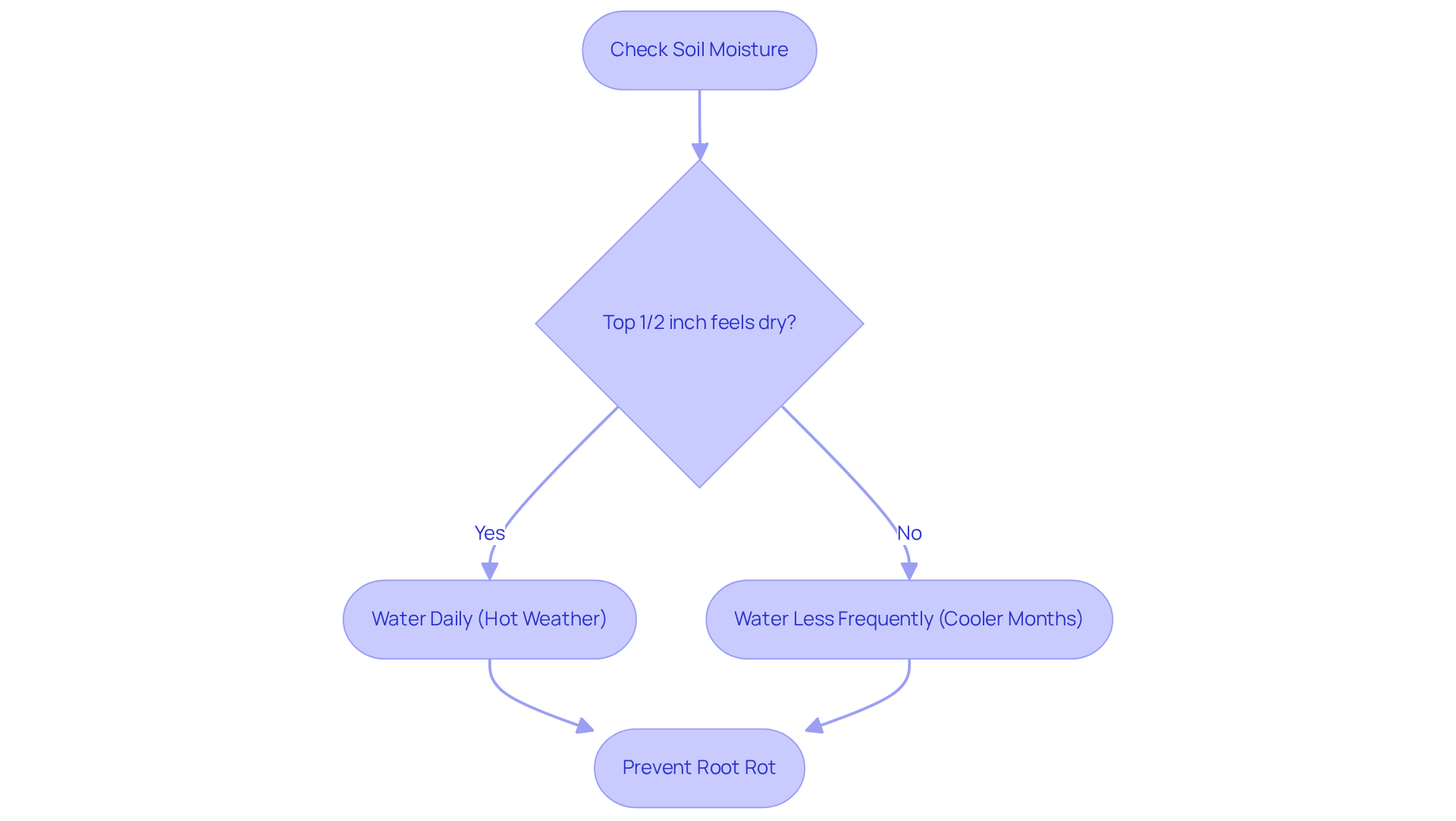
3. Prepare Well-Draining Soil for Optimal Growth
To ensure optimal development of your double mahoi, it is essential to prepare a well-draining soil mix for the fruit-bearing species. A highly effective combination consists of equal parts peat moss, perlite, and compost. This blend not only facilitates excellent drainage but also retains the necessary moisture and nutrients crucial for healthy growth.
Furthermore, incorporating organic matter into your soil enhances fertility and improves its structure, which is vital for robust root development. Soil experts stress that adequate drainage is essential for avoiding root rot and ensuring that fruit-bearing species flourish in their tropical surroundings.
The ideal soil pH range for plant cultivation is between 5.5 and 6.5, which is essential for optimal nutrient uptake. Remember, inadequate drainage can lead to root decay, greatly affecting the health of vegetation.
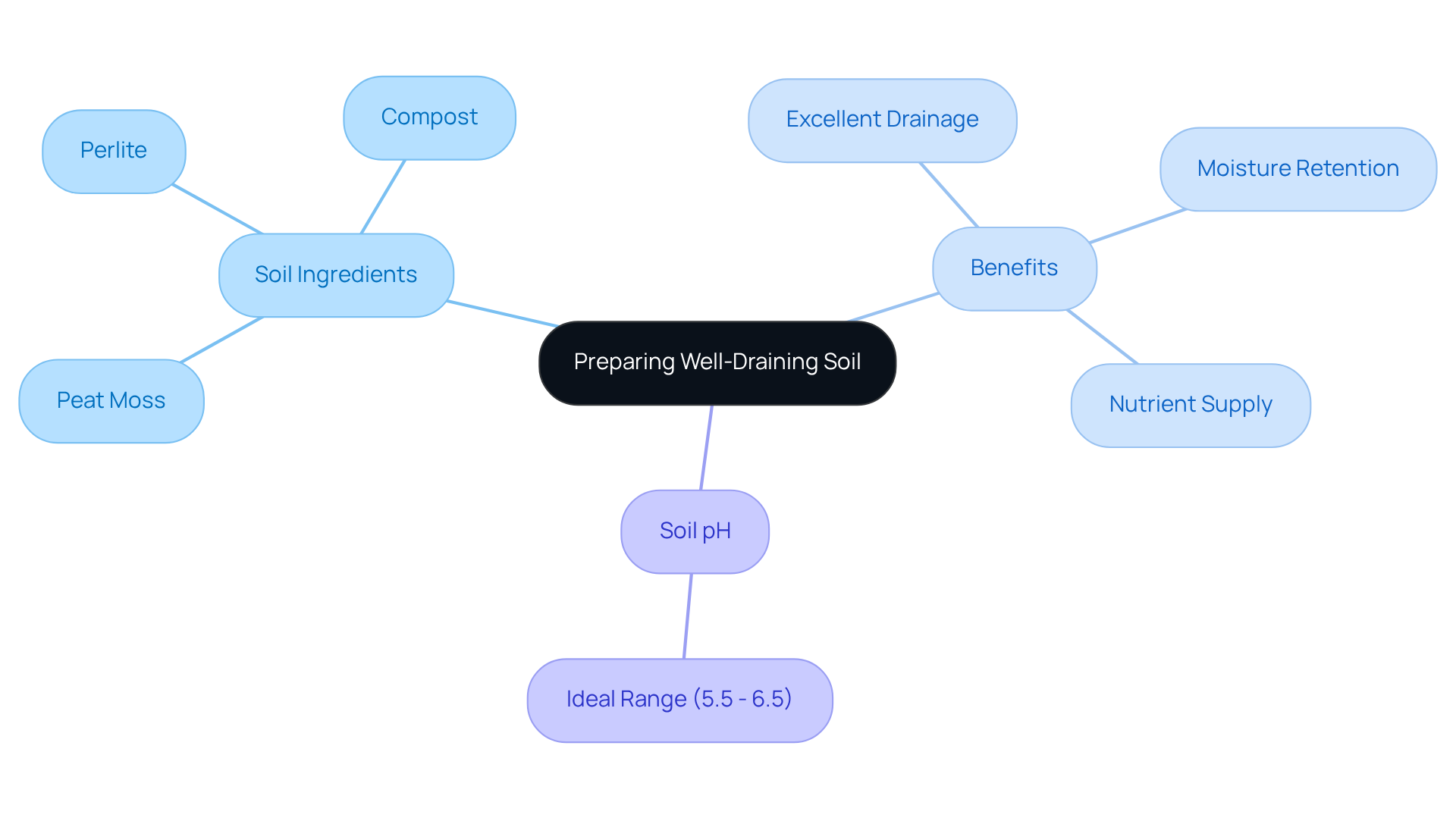
4. Provide Adequate Sunlight for Healthy Growth
Double Mahoi varieties flourish in full sun, needing at least 6 to 8 hours of direct sunlight each day. For outdoor cultivation, it is advisable to select a location such as a south-facing garden bed that receives unfiltered sunlight throughout the day. When cultivating indoors, positioning the greenery near bright, unobstructed windows will enhance light exposure.
To prevent sunburn and promote healthy development, it is essential to acclimate your banana crops to direct sunlight over a duration of 1-2 weeks. Adequate sunlight is crucial not only for strong development but also for boosting fruit production, leading to a more plentiful harvest. Signs of inadequate sunlight include pale or yellowing leaves and leggy growth, indicating that the organism may require more light.
Additionally, utilizing reflective surfaces behind the greenery can improve light exposure, while frequently rotating the foliage ensures even sunlight distribution. Experts emphasize that bright, unfiltered sunlight is vital for efficient photosynthesis, which directly impacts the health of the vegetation and its ability to produce double mahoi.
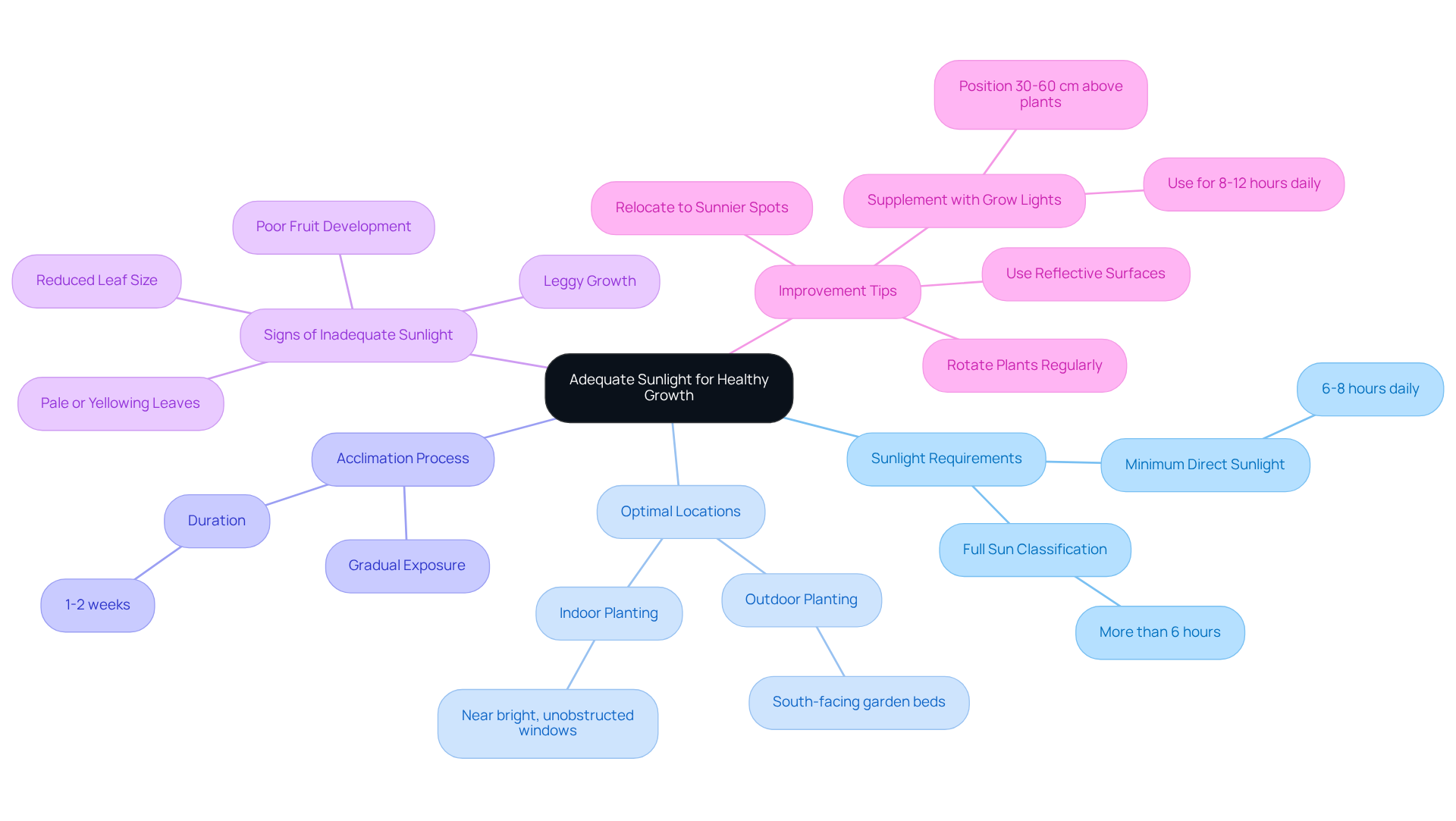
5. Fertilize Regularly to Enhance Growth and Yield
To enhance growth and yield, it is essential to fertilize your double mahoi cultivations every 2 to 4 weeks during the growing season. A balanced fertilizer that contains a higher potassium content is recommended, such as those with NPK ratios of 8-10-10 or 10-8-20. This is crucial, as potassium is vital for the optimal development of this fruit. Additionally, organic options like compost or well-rotted manure can significantly benefit your plants by improving soil health and supporting beneficial microorganisms.
Monitoring your plants for signs of nutrient deficiency is also important. For instance, yellowing leaves may indicate a shortage of nitrogen, phosphorus, or potassium. It is advisable to adjust your fertilization routine accordingly to address these deficiencies. By consistently overseeing your crops and making prompt modifications, you can ensure that your fruit-bearing plants thrive and produce abundantly.
Remember, attentive care and a keen awareness of nutrient needs are fundamental to achieving a fruitful harvest.
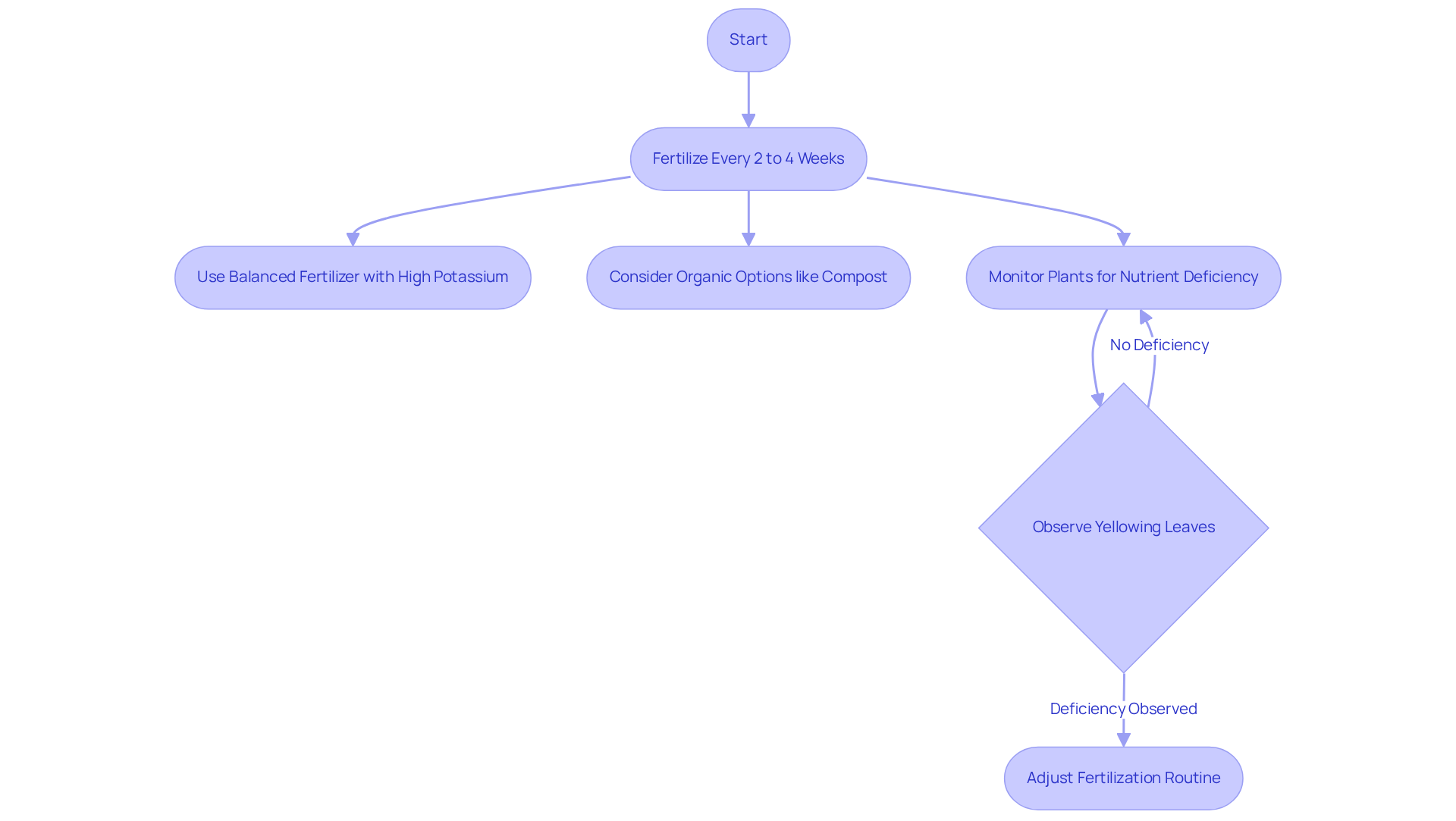
6. Implement Effective Pest Management Techniques
Implement integrated pest management techniques to safeguard your crops from common pests such as aphids and spider mites, especially for Double Mahoi. Regularly examine your greenery for indications of infestation, including discolored leaves or webbing.
Utilizing organic insecticides or neem oil as a preventive measure can be effective, similar to the methods used for managing passion vine hoppers on passion fruit vines. Additionally, maintaining good garden hygiene by removing debris and weeds can significantly reduce pest populations.
Understanding how to recognize and manage pests naturally will not only benefit your fruit trees but also enhance the overall well-being of your tropical garden.
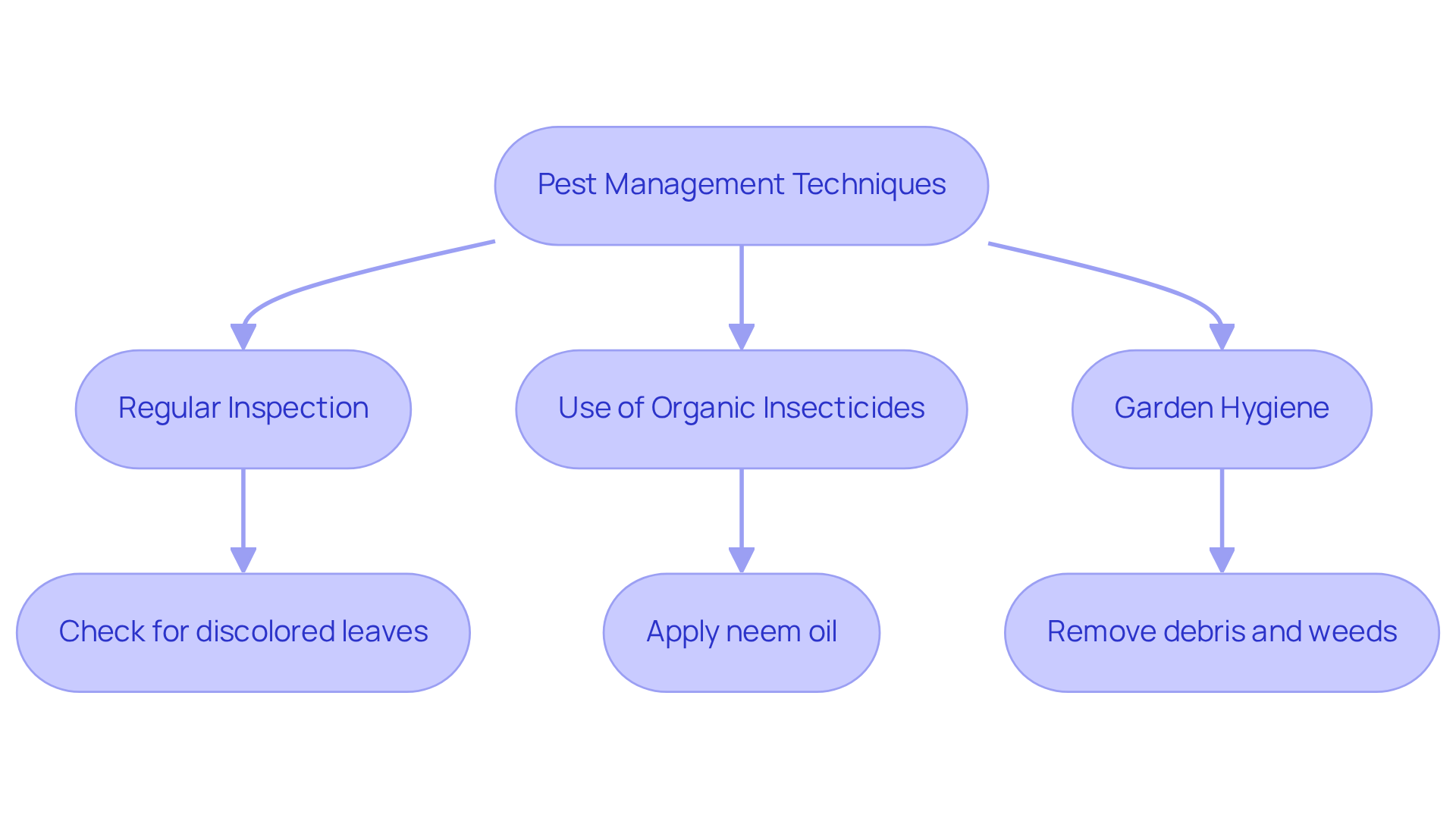
7. Prune Double Mahoi Banana Plants for Better Yield
Pruning your double mahoi banana specimens is essential for maintaining their health and maximizing fruit production. By eliminating dead or damaged leaves and controlling suckers, you improve airflow around the vegetation, which is crucial for preventing disease and encouraging robust development. Aim to retain one or two healthy suckers, as this supports future growth and fruiting. The ideal period for trimming is early spring, just before the growing season begins, allowing the vegetation to recuperate and flourish.
Research indicates that proper pruning can significantly enhance fruit yields. For instance, studies have shown that plant species can achieve outputs of up to 32.3 tons per hectare when managed effectively, with moderate foliage retention also improving legume intercropping yields. Specifically, fruit yield was recorded at 28.6 tons per hectare when five leaves were retained, highlighting the positive impact of balanced pruning. Horticulturists emphasize that maintaining a balance in foliage retention—such as keeping five leaves—can lead to improved overall productivity. As noted by specialist Jules Ntamwira, "A decrease in the quantity of foliage improves bean production for both legume varieties," underscoring the linked advantages of trimming in intercropping systems.
Effective pruning methods for double mahoi plants involve using clean, sharp tools to first remove older, brown leaves, followed by any inner leaves that show signs of damage. This approach not only helps preserve the health of the tree but also enhances its fruit yield, ensuring that your vegetation remains strong and productive during the growing season. Furthermore, light trimming can be beneficial year-round, allowing for continuous upkeep without the risks associated with drastic pruning, which can negatively impact overall vegetation health.

8. Monitor Plant Health Regularly for Early Issue Detection
Regular health monitoring is essential to ensure the vitality of your double mahoi banana plants. Begin by observing initial indicators of stress, such as:
- Wilting
- Yellowing foliage
- Stunted development
Specific nutrient deficiencies can also manifest as stress indicators; for instance:
- Potassium deficiency may cause yellowing of leaf edges
- Nitrogen deficiency can lead to overall yellowing and stunted growth
Pests and diseases can quickly compromise the health of your vegetation, so addressing these issues promptly is crucial.
Research suggests that early detection of vegetation stress can significantly enhance recovery outcomes. Certain techniques, such as Raman spectroscopy, allow for the identification of stressed flora within 48 hours after exposure to unfavorable conditions. Maintaining a gardening journal can also be advantageous, as it enables you to track changes in vegetation health over time and refine your care techniques accordingly.
As noted by horticultural pathologist Alvaro Fuentes, recognizing these stress indicators early can lead to timely interventions, ensuring your garden flourishes. By being vigilant and proactive, you can create a healthy environment for your double mahoi banana plants.
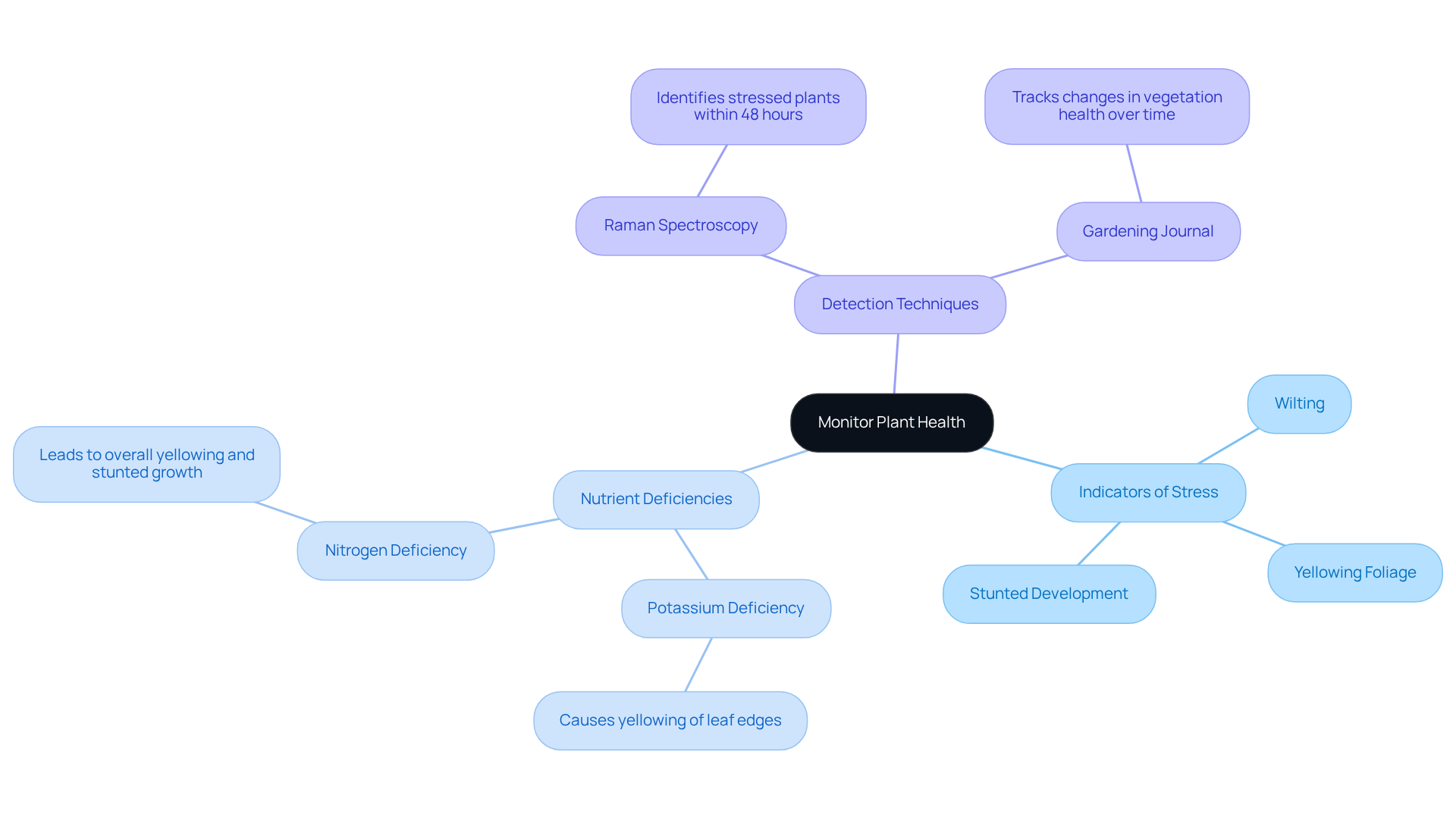
9. Use Mulch to Retain Moisture and Suppress Weeds
Applying a layer of organic mulch around your double mahoi species is essential for moisture retention and weed suppression. Effective materials, such as straw, wood chips, or banana leaves, not only conserve moisture but also enrich the soil as they decompose. Aim for a mulch thickness of 2-3 inches, ensuring it is kept a few inches away from the base of the vegetation to prevent rot and excessive moisture that can lead to root issues. This practice improves soil health by incorporating organic matter and stabilizes moisture levels, which is crucial for robust vegetation.
Studies indicate that well-placed mulch can reduce evaporation by up to 58.8%, significantly enhancing water retention in the soil. Specialists emphasize that appropriate mulching methods not only aid in moisture conservation but also effectively inhibit weeds, fostering an optimal environment for your fruit to thrive.
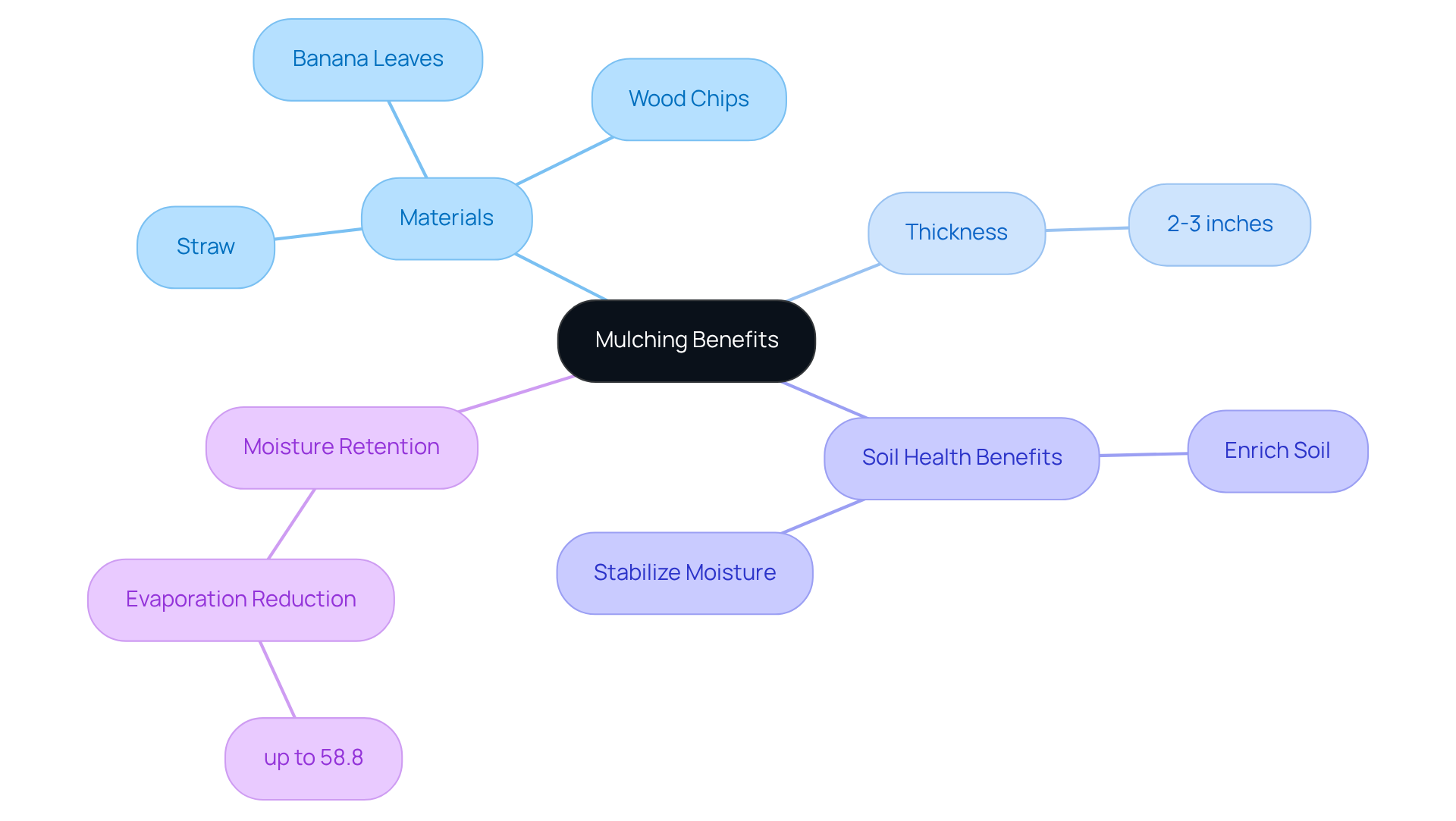
10. Adjust Care Practices Seasonally for Optimal Growth
To ensure optimal development of double mahoi varieties, adjusting care methods according to the seasons is essential. During the hotter months, it is beneficial to increase the frequency of watering and fertilization every 7-14 days to promote vigorous growth, as banana species thrive in temperatures between 79°F and 86°F. It is crucial to monitor temperatures, as conditions below 59°F can impede development. Conversely, as temperatures drop, it is advisable to reduce both watering and fertilization, allowing the plants to transition into a slower growth phase.
Protecting your plants from frost is vital; cover them or move potted varieties indoors when temperatures fall below 32°F. These seasonal adjustments not only support the health of your fruit-bearing plants but also enhance their yield throughout the year. Remember, these fruits typically require 9 to 12 months from planting to harvest, with the first bunch often being smaller than subsequent ones, making consistent care vital for successful fruiting.
Additionally, the ideal soil pH range for these crops is between 6.0 and 7.5, which helps establish optimal growing conditions. As Greg Alder states, 'You want to know that when you put in a single banana plant, in a few years you will have many banana plants.
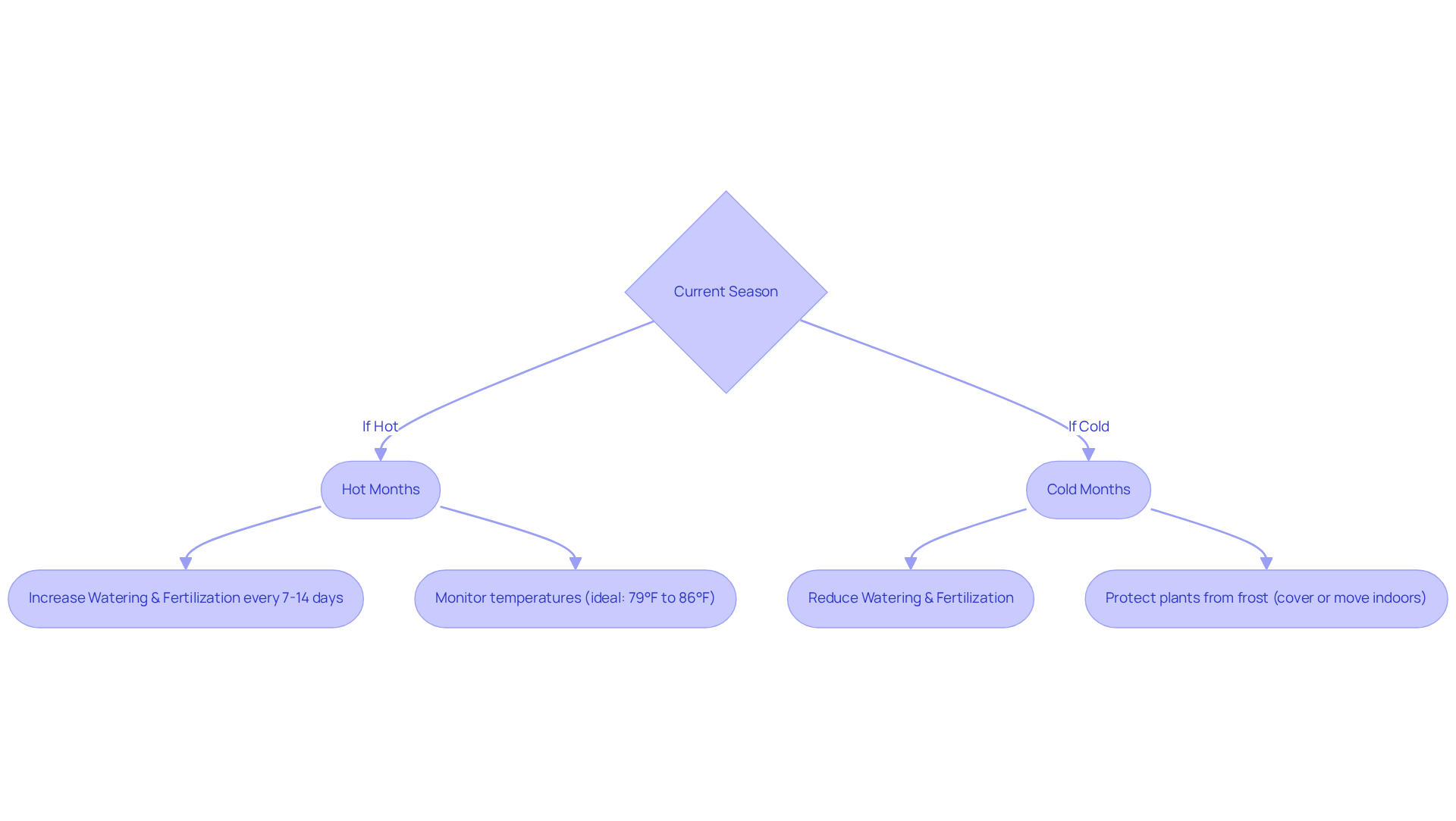
Conclusion
Growing double Mahoi banana plants can be a rewarding endeavor when approached with the right knowledge and techniques. By focusing on essential practices such as:
- Selecting healthy specimens
- Providing adequate water and sunlight
- Maintaining optimal soil conditions
Gardeners can ensure robust growth and fruitful yields. The journey from planting to harvest is filled with critical steps that, when executed properly, lead to a thriving banana garden.
Key strategies include:
- The importance of regular fertilization to enhance growth
- Effective pest management to protect against common threats
- The significance of seasonal adjustments in care practices
Additionally, techniques such as proper pruning and the use of mulch play a vital role in maintaining plant health and maximizing fruit production. Regular monitoring of plant health allows for early detection of issues, ensuring timely interventions that promote vitality and productivity.
Ultimately, successful cultivation of double Mahoi banana plants hinges on attentive care and informed practices. By implementing these tips and best practices, gardeners can create an optimal environment for their plants, leading to abundant harvests and a fruitful gardening experience. Embrace the journey and enjoy the rewards that come from nurturing these vibrant tropical plants.
Cultivate Your Tropical Oasis with Double Mahoi Bananas!
Start your gardening journey today and enjoy abundant harvests with Everglades Farm's premium plants.
Frequently Asked Questions
Where should I purchase double mahoi banana plants?
It is recommended to acquire double mahoi banana plants from a reliable nursery, such as Everglades Farm, which offers healthy specimens with vibrant green foliage and a strong root system.
What characteristics should I look for in healthy double mahoi banana plants?
Healthy double mahoi banana plants should exhibit vibrant green foliage, a strong root system, and show no signs of pests.
What is the importance of sourcing plants from reputable nurseries?
Sourcing from reputable nurseries like Everglades Farm ensures that you receive robust, well-packaged plants that are more likely to thrive and bear fruit, enhancing your gardening experience.
How often should I water double mahoi banana plants?
Double mahoi banana plants require consistent moisture, necessitating regular watering. During hot weather, daily watering may be needed, while cooler months allow for reduced frequency.
How can I determine when to water my double mahoi banana plants?
A practical approach is to check the top 1/2 inch of soil; if it feels dry, it's time to water. This helps prevent root rot caused by overly saturated conditions.
What humidity levels are ideal for double mahoi banana plants?
Maintaining humidity levels between 50 and 60 percent is essential for the health of double mahoi banana plants.
What type of soil is best for double mahoi banana plants?
A well-draining soil mix consisting of equal parts peat moss, perlite, and compost is ideal for double mahoi banana plants, as it facilitates excellent drainage while retaining necessary moisture and nutrients.
What is the ideal soil pH for cultivating double mahoi banana plants?
The ideal soil pH range for cultivating double mahoi banana plants is between 5.5 and 6.5, which is essential for optimal nutrient uptake.
Why is adequate drainage important for double mahoi banana plants?
Adequate drainage is crucial to avoid root rot and ensure that fruit-bearing species flourish in their tropical surroundings.


